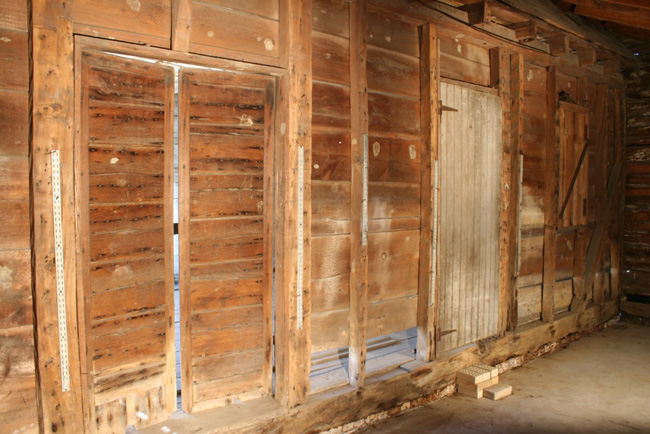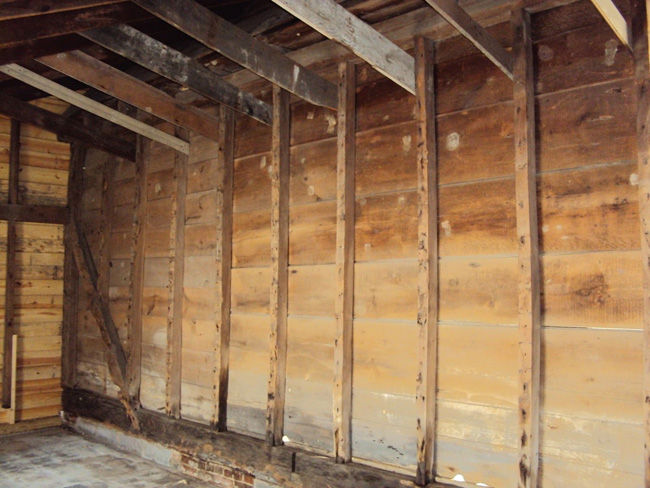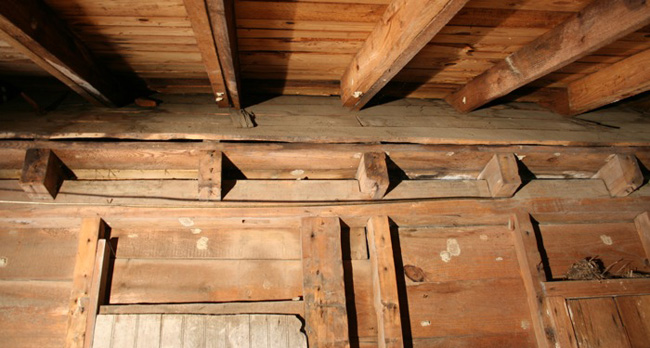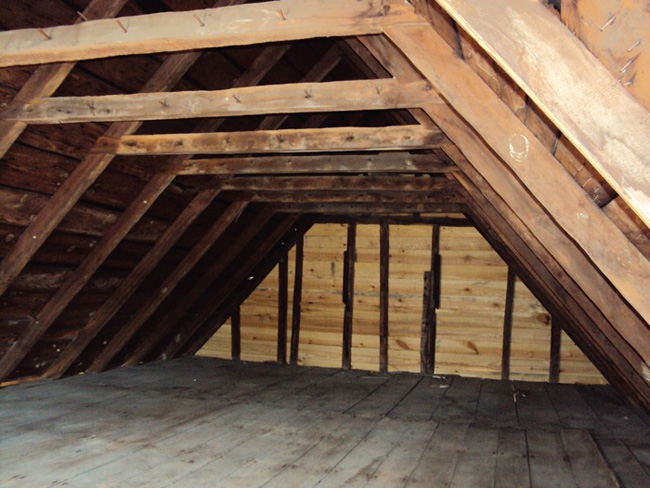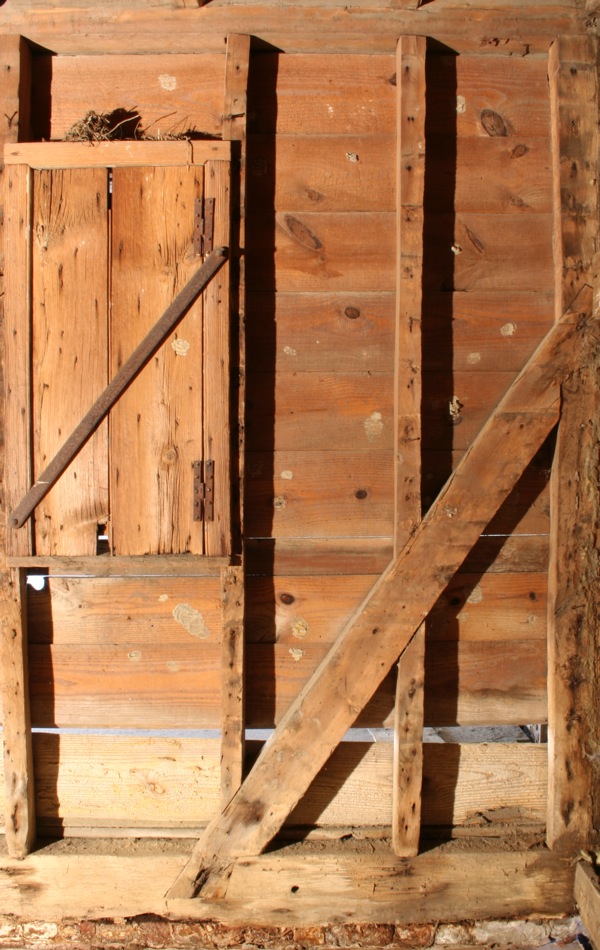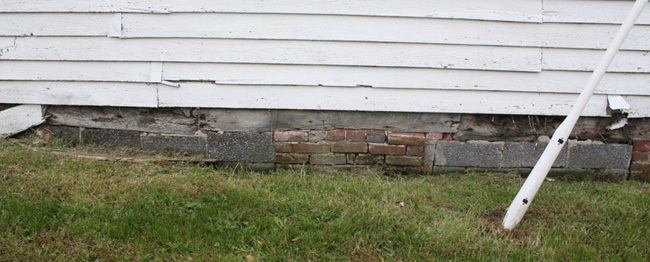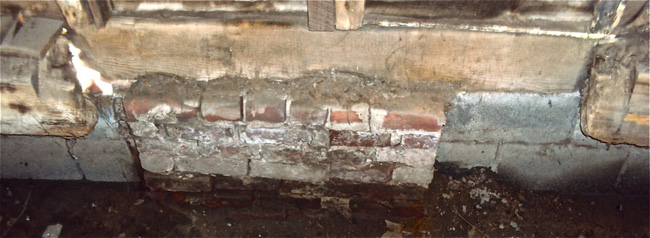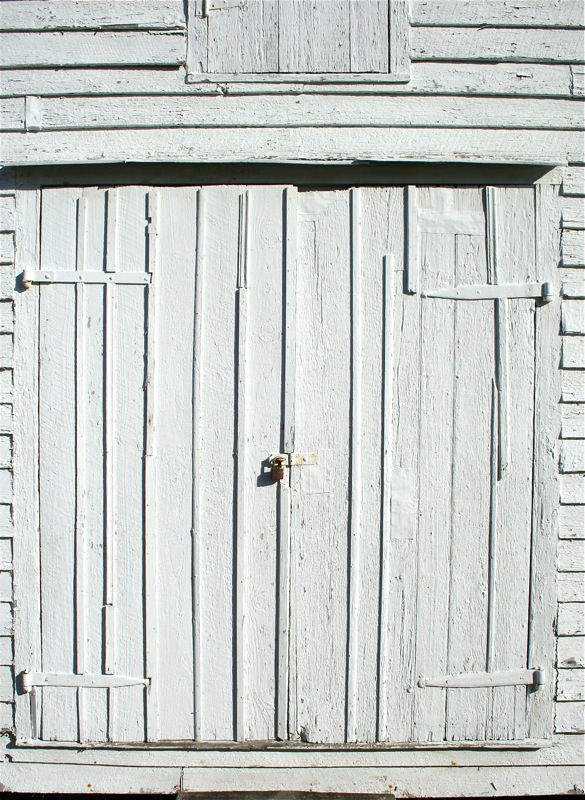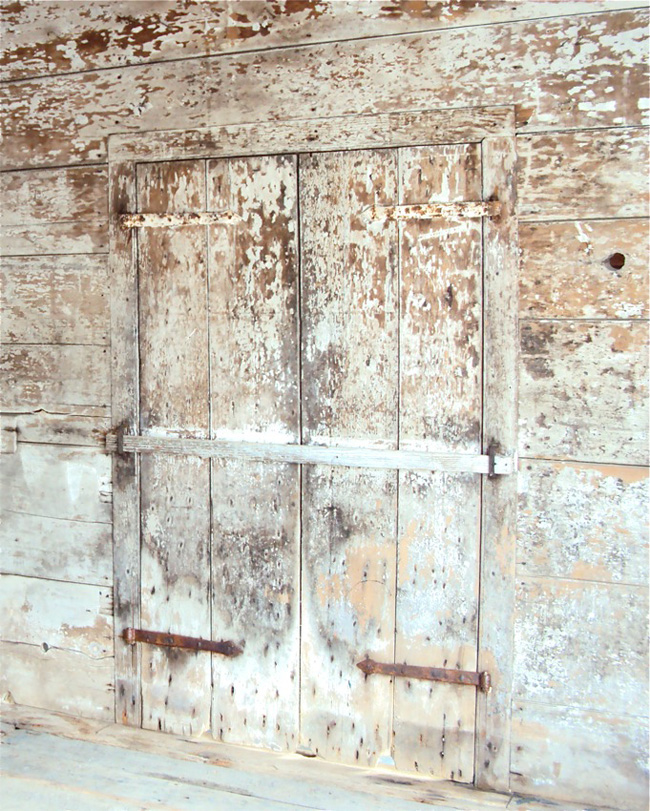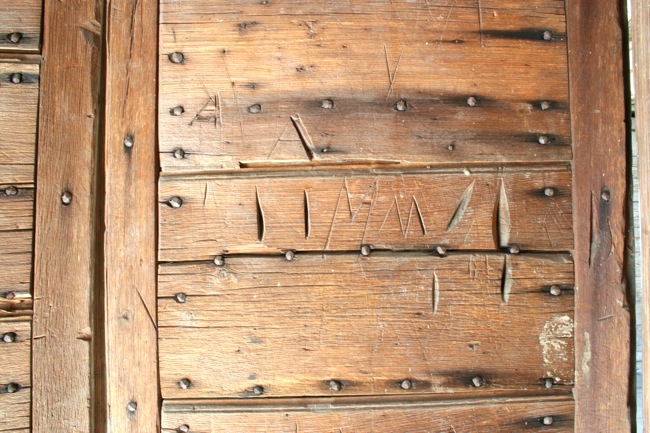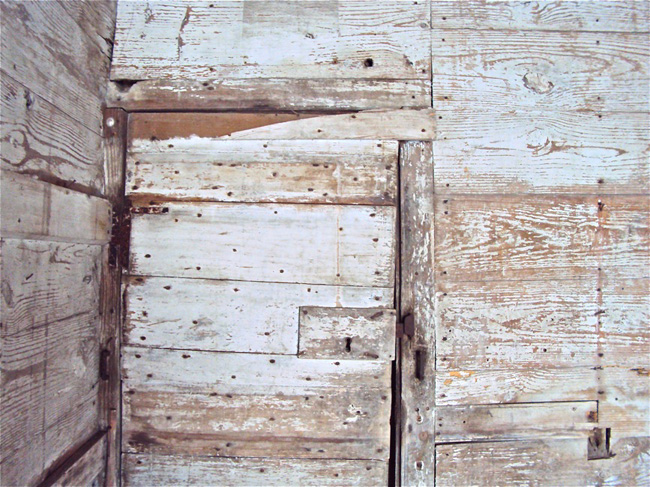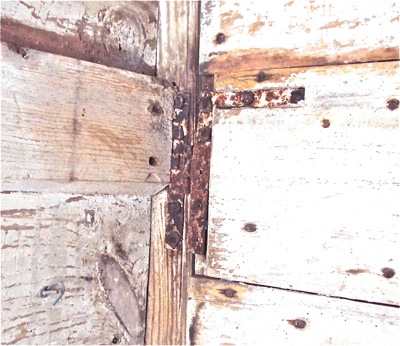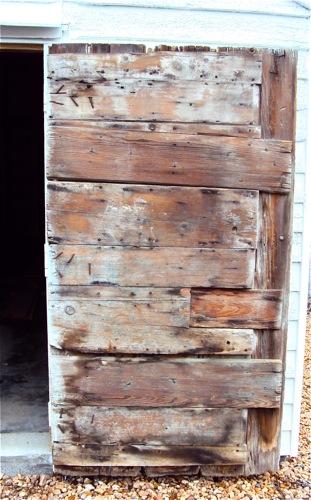Architectural Information
Architectural Description - Exterior
Framing
The Thomas James Storewas built with an "English frame," meaning that it has a joined box frame with a base of continuous sills. English framing was common in rural construction from approximately the time of the American Revolution through the middle of the nineteenth century. The joints are mortise and tenons that are pegged only at the more significant joints. The building has half dovetail lapped down braces, and flush-framed walls intended for an interior wall finish. The roof is framed in the common rafter style footed on a board false plate, with the rafters neatly aligned with the joists.
Exterior of original front (now east) wall of old store - photo by Jorin Hood
Exterior of original back (now west) wall of old store
The sills and corner posts of the frame are cut from oak, with most of the other framing components made of yellow poplar. Since these types of wood were more commonly used earlier than the construction date of the Thomas James Store, they are likely a simple reflection of available timber in the area at that time. The structural timbers are hewn square and pit-sawn, a technique which was commonplace in Virginia until approximately 1820. The nails used in framing the store are machine cut with double-struck heads, which were only commonly used in the area between 1805 and the early 1820s.[i] The nails used to clinch the double-thickness doors, however, are all forged, hand-made nails - machine-cut shanks usually break in the clinching.
Exterior (present east) - details of original roof structure - photo by Jorin Hood
Attic - note neatly spaced nails on collar ties
Exterior (present east) wall showing counting room window and corner brace - photo by Jorin Hood
[i]Willie Graham, "Sibley Store, Mathews Courthouse, Virginia, ca. 1810-20," Report, 3 March 2006, pp.3-4.
Foundation
Photo by Jennifer Glass
The foundation of the Thomas James Store is of brick piers laid in English bond with concrete block infill. This is probably not the original foundation, as the building was likely moved and set on a new foundation. However, since English bond was not commonly used past about 1825, the foundation is early if not original.[i]It is interesting that the foundation wall on the original front (now – after the building was moved from its first site – east) wall is full length, as it probably was when it was erected.It is as if, after the building was moved to its present site, the front wall was still fully finished to receive customers.
It seems that the building may originally have been set above a raised cellar, rather than the crawl space that currently separates the floor joists from the ground. The joists beneath the store appear to be lime-washed beneath the floorboards; this could be either an aesthetic detail or an early procedure to prevent insect infestation.[ii]If aesthetic, it only makes sense if the joists were to be seen from below, as in the case of a cellar.
The illustration above shows the original brick pier foundation and the north wall foundation prior to the changes of 2010, which are detailed in Preservation 2010 Report.
[i] Graham, p.5.
[ii] Mark Wenger, "Thomas James Store – Matthews (sic), Virginia," Report, 27 November 2008, p.7.
Roof
The Thomas James Store has a gable roof with an approximately 40 degree pitch, with gently sloped shed roof additions on the east and west sides of the building. Since it is likely that the original front façade (facing Main Street, or west) of the building was the side that now faces east, the gable was originally side-oriented.
The roof of the store is currently covered in asphalt shingles, which are a modern alteration. Early roofing shingles were found in the rafters of the shed additions, having been used to shim up the rafter feet. These shingles likely came from the roof of the store when it was re-shingled, and were square butt shingles that had been laid with an exposure of approximately 6¾".[i]
[i]Wenger, p.5.
Cladding
The store is clad in mill-sawn beaded weatherboard siding with corner boards. This is not the original siding, which was likely replaced with the construction of the east and west shed additions. (Much of this siding was found in 2010 to be so rotten that it was replaced with machine-cut, yellow pine boards - the exterior surfaces of both north and west walls are entirely replaced, parts of the other two walls were replaced.None of the 1810-1815 period siding remains, anyway. See Preservation 2010 Report.)
Upon his investigation of the building, Mark Wenger noted that the placement of the original weatherboard could be seen in parts of the original exterior east wall, where framing was exposed. Dirt and debris from inside of the wall had collected on the upper edge of each weatherboard, leaving behind a mark on the exterior of the stud even after the original cladding was removed. Measuring the distance between these marks shows that the exposure of the original weatherboards was between 7" and 7 3/8".[i]The siding noted above was kept, as much as possible, during the stabilization project of summer, 2010.However, all of the north wall siding had to be replaced, with pine boards exactly matching the earlier ones; all of the west wall siding was likewise replaced, the 1950s era windows removed, and a new door consisting of vertical boards in the old manner (fabricated by Henry Schlenk), with reproduction hinges and staple fastener, with an antique latch installed.Siding replacement on the east and south walls was minimal.
[i] Wenger
Chimney
Sill (present north side, prior to 2010 preservation) interior showing cut for chimney
The Thomas James Store does not have a standing chimney. However, an examination by Mark Wenger produced evidence that the building did at one time have a chimney on the current north gable elevation, with a fireplace in the counting room of the store. A chimney thus located is almost universal in existing rural southern stores with a similar floor plan from this time period.
The original sill on the north elevation of the building has a gap centered under the gable of the façade. A thin insert of timber closed the gap (until the sill was reinforced in 2010). This is where the chimney, with a width of 55", would have risen from the foundation. The two cut ends of the sill could be seen from the inside of the building beneath the floorboards, and each had been chased with a lap mortise into which the header of the hearth would have been inserted. The measurement between these laps, and thus the width of the original hearth, is 56¼". Although the original joist at the front of the hearth has been replaced, the joist's original drop mortises were still in place; measuring from these mortises to the inside of the north wall frame suggests that the hearth was 27" deep. The east side of the chimney was located 60" from the inside framing of the east wall. As there is no visible evidence of a fireplace at the attic level of the north gable, it is likely that the chimney had a set of shoulders at approximately attic floor level that narrowed the stack.[i]
[i] Wenger, p.2.
Porch
There was initially some speculation that the Thomas James Store may have had a front porch on the east elevation, due to the relatively un-weathered condition of the double-doors and the absence of shingles on the lower section of the original building's roof, which is now covered by the shed additions. However, an examination of the early sheathing just above the eaves of the original building revealed nails and nail holes indicating the placement of the original shingles. The prior presence of shingles in this location makes it unlikely that there was a porch.[i] This is in keeping with the general architecture of early stores, as porches were much more common on houses and taverns than on retail stores.
[i] Wenger
Openings
South (original north) wall double door - photo by Jorin Hood
Most of the store's original openings are no longer visible from the exterior, as they have been covered with weatherboard or are obstructed by the newer east and west wings. On the south elevation is a batten board double-leaf door which serves as an entrance to the building. Originally, this doorway would have faced the alley (now Maple Avenue) to the north of the building, and was probably used to load goods from the alley into the retail room. Although this opening is original, it was enlarged at some point and the original doorway was destroyed, though three of the original period hinges were kept. Mortises in the top plate of the doorway indicate that the original doorway was 41" wide, allowing 1 1/4" for the plank jamb linings. The original door is no longer in place, but was likely a double-width or "folding" door; it is possible that one of these doors was reused in the south opening of the east wing. It is also possible that the double-leaf door now occupying the enlarged south opening was originally located in the loft doorway directly above.
The other original opening that can still be seen on the building's exterior is the garret or attic doorway directly above the double-leaf door on the south elevation. This opening is approximately 62" in height. Although the framing of the opening is original, the batten board door, sill, and linings for the head and jamb are modern additions. This doorway was likely used for loading and unloading goods from the alley into the attic storage area of the building.
There are three openings on the east elevation of the original store, which are no longer visible on the building's exterior due to the east wing addition. The first is a double-leaf wood batten door, which would have served as the store's main entrance. This door is double-sheathed, with an interior horizontal layer and an exterior vertical layer of laminated sheathing secured together with clinched rosehead nails. The layers are offset 1/2" to form rabbets that fit the opposite door and the stops of the door frame. The exterior faces of the leaves have a beaded edge of approximately 2 1/4" width. The doors are hung on strap hinges with driven pintles and are secured on the interior by a wooden bar that is held at each jamb by a pair of closed keepers or staples. The lower hinges and pintles were badly rusted by 2010 and were replaced by identical, hand-made reproductions.
Interior of original front doors of old store
Detail of exterior of original front doors of old store - photo by Jorin Hood
The other two openings on the east elevation are windows; one of which lit the retail room, and the other the counting room. The retail space window has been enlarged into a doorway, but evidence of the original window can still be seen in the frame. The window was originally framed on the north side by a large post, which was later cut out and moved further northward to create the existing door frame. The cut-off end of the north post still remains in the mortise at its original location. On the south side of the door frame, the dado for the opposite end of the original window sill can still be seen.
The 4/4 wood sash counting room window is approximately centered on the east wall of the original room. There are dados for another window sill cut into the wall next to the existing window, against the original partition location. However, these dados appear to have never been used; the method of installing window frames necessitates the jambs being nailed directly to the flanking studs. Therefore, nail holes on the studs above the dados should be seen anywhere that a window was framed. There are no holes above the dados in this instance, suggesting that the window was originally intended for placement against the partition, but was moved further north before being framed. The exterior shutter on the window is original and, like the doors, is of double-layered sheathing with a beaded edge. It is hung on H-shaped side hinges.[i] The shutter is secured by a wrought iron bar hung on a pin at the top of the jamb and run diagonally across the exterior of the window. A pin at the lower end of the bar would be wedged inside the shutter so that it could not be opened from the exterior. Every piece of the ironwork for this window is original.[ii]
North wall (originally south) single door
Detail of hinge showing leather washers.
On the north elevation of the store, covered on the exterior by weatherboard, is a single original double-sheathed door set against the northwest corner post, which served as an exit from the counting room. It is secured by a stock lock and staple, as well as a wooden bar set in keepers like that on the east entrance. This door swings on small H-L hinges, which are secured to the frame by clinched nails with leather botching behind the heads. All ironwork on this door is original. A simple board was nailed to the top of the door at an early period to keep it firmly shut.It was partly broken off in recent years, exposing the original, unpainted surface below.This raises the important question of whether any surface in the early store was ever lime-washed.
At the garret level of the north façade, also covered on the exterior with weatherboard, are two windows. Originally, these would have flanked the chimney stack.
There are several exterior openings on the east and west shed roof additions that are not original to the store. The west wall of the west wing now serves as one of the building's principal entrances.From about 1950-2010, it featured a modern single-leaf wood paneled door with four lights, with wood tripartite windows, each consisting of a central square fixed light flanked by 2/2 wood sash windows. (These windows and the door were removed in 2010 and the siding all replaced, with the new door being a vertical board-type with reproduction hinges and staple fastener, with an antique latch installed. The west wall siding was also totally replaced at this time.) On the south elevation of the east wing is a single-leaf, double-sheathed wood batten door hung on strap hinges. Although this opening is not original to the store, it seems likely that the double-sheathed door (or at least parts of it) was reused from the original south façade opening after it was widened and a new double-leaf door installed. [iii]
Interior surface of south wall single door
[i] Wenger, pp.5-6.
[ii] Graham, p.3.
[iii] Wenger, pp.6-7.
Works Cited
- Atherton, Lewis A. The Southern Country Store, 1800-1860. Baton Rouge: Louisiana State University Press, 1949.
- Bradley, Stephen E., Jr. Mathews County Virginia, Censuses 1810, 1820, 1830, 1840. Self-published, 1992.
- Deed of sale from Commissioners of the Circuit Court to William N. Trader and John W. Dixon, Jr., 1893, Deed Book 10, page 403, Mathews County Clerk’s Office, Mathews, VA.
- Deed of sale from F. Joseph Sibley to Cecil Sibley, 1945, Deed Book 40, page 361, Mathews County Clerk’s Office, Mathews, VA.
- Deed of sale from Helen Miller Sibley to Cecil Sibley, 1948, Deed Book 43, page 288, Mathews County Clerk’s Office, Mathews, VA.
- Deed of sale from Jerry Fruehbrodt to Michael J. Brown, 2003, Deed Book 295, page 299, Mathews County Clerk’s Office, Mathews, VA.
- Deed of sale from John W. Dixon, Jr. to William N. Trader, 1899, Deed Book 12, page 193, Mathews County Clerk’s Office, Mathews, VA.
- Deed of sale from Mary Sibley to Jerry Fruehbrodt, 1989, Deed Book 148, page 812, Mathews County Clerk’s Office, Mathews, VA.
- Deed of sale from William Trader to Henry and F. Joseph Sibley, 1899, Deed Book 12, page 231, Mathews County Clerk’s Office, Mathews, VA.
- Federal Census of 1850, Mathews County Virginia.
- Graham, Willie. “Sibley Store: Mathews Courthouse, VA.” Unpublished report, March 3, 2006.
- Land Tax Records, 1807-1819. Mathews County Courthouse, Mathews, VA.
- Land Tax Records, 1815-1820. Mathews County Courthouse, Mathews, VA.
- Land Tax Records, 1820-1846. Mathews County Courthouse, Mathews, VA.
- Land Tax Records, 1846-1872. Mathews County Courthouse, Mathews, VA.
- Land Tax Records, 1898. Mathews County Courthouse, Mathews, VA.
- Land Tax Records, 1900. Mathews County Courthouse, Mathews, VA.
- Lounsbury, Carl L. An Illustrated Glossary of Early Southern Architecture & Landscape. New York: Oxford University Press, 1994.
- Martin, Joseph, ed. A New and Comprehensive Gazetteer of Virginia and the District of Columbia. Westminster, MD: WIllow Bend Books, 2000.
- Mason, Polly Cary. Records of Colonial Gloucester County Virginia, Volume I.
- Matheny, Emma R., and Helen K. Yates, ed. Kingston Parish Register Gloucester and Mathews Counties 1749-1827.
Mathews County Commissioner of the Revenue. Property Card, Parcel 26A3-A-107. County of Mathews, VA. http://www.emapsplus.com/vamathews/maps (accessed November 6, 2008).
- Mathews County Historical Society. History and Progress: Mathews County, Virginia. Mathews County, Virginia: Mathews County Historical Society, 1982.
- Mathews County Virginia Executors’ Bonds, 1795-1825, and Guardian Bonds, Book B, 1806-1822.
- Mathews County Visitor and Information Center. “Mathews History and Statistics.” Mathews County Visitor and Information Center. http://www.visitmathewsva.com/statistics.html (accessed October 25, 2008).
- Receipt dated May 30, 1810. Richard Billups papers. Box 4, Folder 1. Swem Library, College of William & Mary, Williamsburg, VA.
- Wenger, Mark. “Thomas James Store – Matthews (sic), Virginia.” Report, 27 November 2008.
- Will of Cecil Sibley, 1987, Will Book 17, page 537, Mathews County Clerk’s Office, Mathews, VA.
